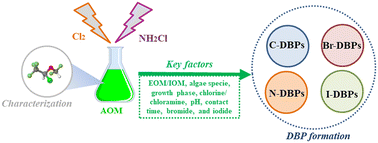Algal organic matter as a disinfection by-product precursor during chlor(am)ination: a critical review
Abstract
Algal organic matter (AOM) is a major precursor of disinfection by-products (DBPs) during disinfection. The goal of this study was to critically review available literature about DBP formation from AOM chlor(am)ination. Fifty-six documents from 2010 to 2022 were selected from Web of Science and Scopus databases for further analysis. Previous AOM characterization can indicate DBP formation, but there are no universal predictive parameters and extensive characterization is beneficial. Disinfection parameters (e.g., disinfectant type, dose and contact time), AOM characteristics (e.g., algal species and growth phase), and water quality (e.g., pH, temperature, concentrations of bromide and iodide) all impact DBP yields. Formation of DBPs from AOM is often dominated by trihalomethanes (THMs) and haloacetic acids (HAAs), which reached maximum yields of THMs 177 and 52 μg mg DOC−1, respectively, during formation potential tests. However, yields of haloacetonitriles (HANs) and haloacetamides (HAcAms) can be notably high on occasion, as indicated by respective maximum yields of 103 and 160 μg mg DOC−1 during chlorination of Synechococcus sp. of algae. AOM treatment methods require careful evaluation, considering that some can increase DBP formation, notably ozone (22–781%) and UV (5–95%). Conventional treatment processes resulted in AOM removal typically <65%, thus additional processes, such as ultrafiltration and/or adsorption, downstream of clarification are likely required to effectively control DBP formation from AOM.

- This article is part of the themed collection: Environmental Science: Water Research & Technology Recent Review Articles


 Please wait while we load your content...
Please wait while we load your content...